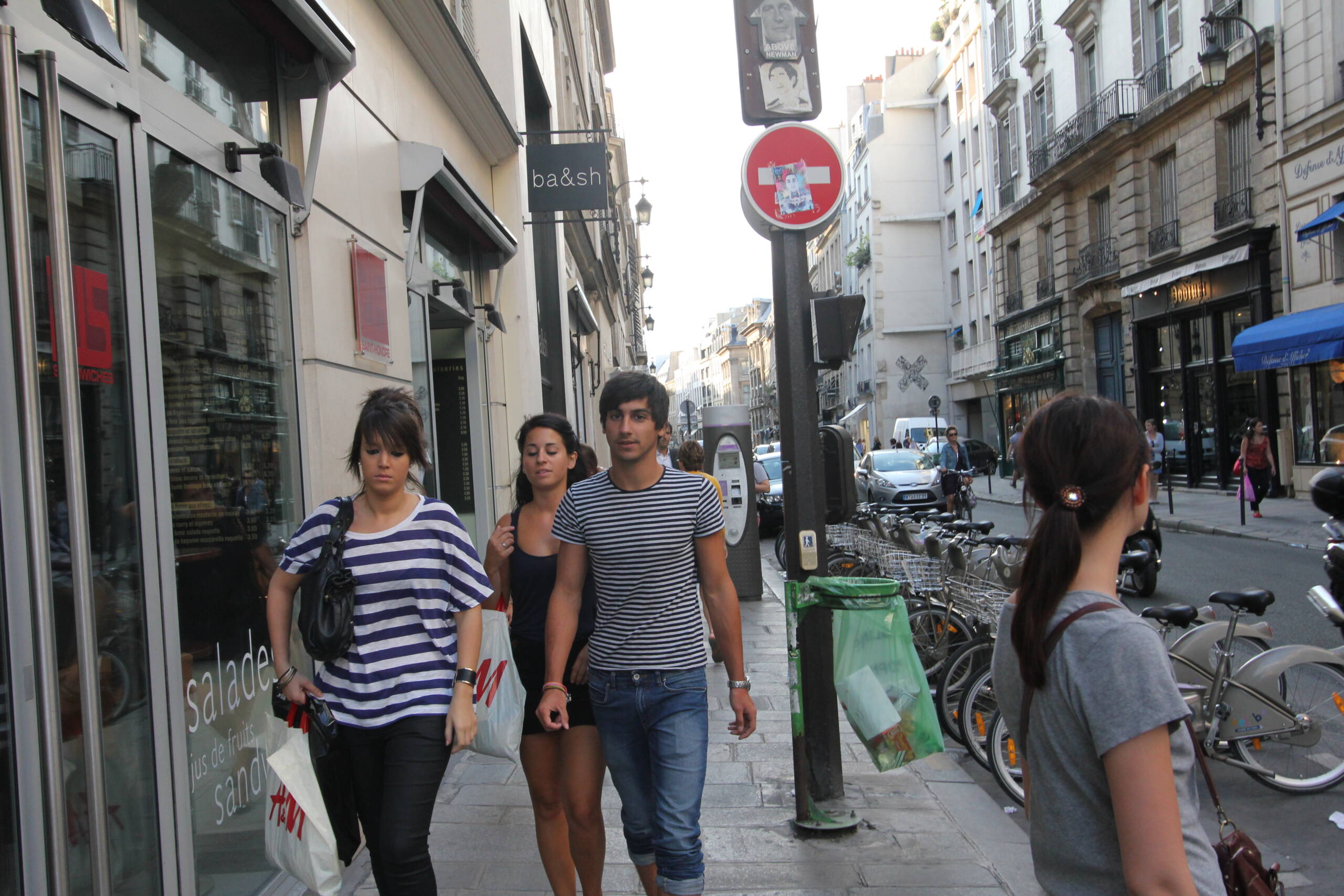The Poetics of the Street
Street photography occupies a peculiar and enviable niche in the hierarchy of visual art. Unlike portraiture, which relies upon consent and often performance, or landscape photography, which is preoccupied with the grandeur of geological time, the street photograph is suspended in the liminal space between chance and intention. It is a discipline for those who have relinquished the fantasy of control, for the practitioner is always both author and spectator, hunter and witness. One merely positions oneself at the seam of human traffic, sets the stage by virtue of being present, and then waits for the world to conspire in its own unscripted theater.

This image, captured along a Parisian street, demonstrates precisely that paradoxical alchemy of randomness and structure. At first glance, it is a slice of the mundane: three young figures emerging toward the camera, one more figure receding from it, and the familiar geometry of narrow European architecture. Yet the longer one gazes, the more resonant patterns unfold. The young man in a fitted striped shirt unwittingly takes center stage. His sartorial choice places him in quiet dialogue with the woman to his left, who wears a looser variation of the same motif. What appears to be accidental repetition instantly assumes symbolic gravity—an urban rhyme in cotton and thread, a reminder that the streets themselves orchestrate these echoes.
The woman in grey, captured from behind, becomes the foil to this accidental symmetry. Her muted tones provide a kind of visual ballast, anchoring the otherwise vibrating horizontals of navy and white. She is anonymous, almost spectral, her identity withheld, as though reminding us that in the theater of the street, protagonists and extras are interchangeable depending on the direction of one’s gaze. Even her ponytail, modestly tied, accentuates her role as the unknowing counterpoint to the bold stripes in the foreground.
And then there is the grammar of the urban environment itself. The red “no entry” sign hovers like an imperious punctuation mark, its circular defiance set against the receding orthogonals of the street. Directly beneath it, the boutique placard “ba&sh” hangs in muted serif font, an emblem of commerce dangling over the very bodies that constitute its clientele. On the shop window to the left, the word “salade” is faintly visible, ghostlike in its transparency, contributing a culinary whisper to the polyphony of the street. These fragments of text and signage remind us that cities are not merely built; they are endlessly annotated, their meanings inscribed in every corner, every sticker, every discarded poster.
The green trash bag suspended from a lamppost, flapping ever so slightly, injects another note of narrative contrast. It is vulgar, practical, and profoundly necessary. Its presence undermines any temptation to romanticize the city into a postcard, reminding us that all urban beauty is alloyed with debris. To exclude such an element would be to falsify the street’s story, but to include it—consciously or unconsciously—is to affirm that life cannot be parsed into tidy categories of elegance and ugliness. The sublime resides in the simultaneity of both.
Even the bicycles, lined in disciplined rank, participate in the composition. They promise motion and yet remain inert, their wheels silent, their seats awaiting the imprint of anonymous commuters. In their stillness, they form a counterpoint to the movement of the pedestrians in the foreground, suggesting that the street is always oscillating between stasis and flux. The street photographer, perched between these states, becomes the medium through which that oscillation is frozen into coherence.
What makes this art form endlessly alluring is precisely its resistance to prediction. The photographer cannot script the striped shirts, cannot choreograph the convergence of signage, cannot instruct the passerby to hold her shopping bag at just such an angle. These elements simply happen, summoned by the city itself. To photograph them is not an act of dominion but of surrender, a recognition that the world, in all its fleeting disorder, contains more poetry than we could ever invent.
To walk with a camera in hand, then, is to place oneself in a perpetual state of readiness—not unlike a reader waiting for the next line of a poem to reveal its rhyme. The shutter, when pressed, is the period at the end of a sentence already written by the street. And therein lies the great paradox: though the image bears your name, the author is always the city. The people who cross your lens, the refuse that drifts at your feet, the signs and shadows that punctuate your frame—they are the true co-conspirators. You are merely their archivist.
Street photography thus reminds us of a truth larger than art: that our lives, too, are composed of accidental symmetries, fleeting harmonies, and juxtapositions we rarely notice until they are frozen in retrospect. Each image is a quiet insistence that the world does not need embellishment to be beautiful, only attention.